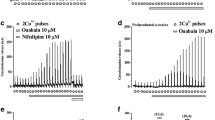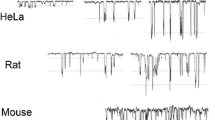Summary
In bovine adrenal medullary cells, we reported that 22Na+ influx via nicotinic receptor-associated Na+ channels is involved in 45Ca2+ influx, a requisite for initiating the secretion of catecholamines (Wada et al. 1984, 1985b).
In the present study, we investigated whether the inhibition of Na+-pump modulates carbachol-induced 22Na+ influx, 45Ca2+ influx and catecholamine secretion in cultured bovine adrenal medullary cells. We also measured 86Rb+ uptake by the cells to estimate the activity of Na+, K+-ATPase. (1) Ouabain and extracellular K+ deprivation remarkably potentiated carbachol-induced 22Na+ influx, 45Ca2+ influx and catecholamine secretion; this potentiation of carbachol-induced 45Ca2+ influx and catecholamine secretion was not observed in Na+ free medium. (2) Carbachol increased the uptake of 86Rb+; this increase was inhibited by hexamethonium and d-tubocurarine. In Na+ free medium, carbachol failed to increase 86Rb+ uptake. (3) Ouabain inhibited carbachol-induced 86Rb+ uptake in a concentration-dependent manner, as it increased the accumulation of cellular 22Na+. These results suggest that Na+ influx via nicotinic receptor-associated Na+ channels increases the activity of Na+, K+-ATPase and the inhibition of Na+, K+-ATPase augmented carbachol-induced Ca2+ influx and catecholamine secretion by potentiating cellular accumulation of Na+. It seems that nicotinic receptor-associated Na+ channels and Na+, K+-ATPase, both modulate the influx of Ca2+ and secretion of catecholamines by accomodating cellular concentration of Na+.
Similar content being viewed by others
References
Aunis D, Garcia AG (1981) Correlation between catecholamine secretion from bovine isolated chromaffin cells and [3H]-ouabain binding to plasma membranes. Br J Pharmacol 72:31–40
Baker PF (1972) Transport and metabolism of calcium ions in nerve. Prog Biophys Mol Biol 24:177–223
Banks P (1967) The effect of ouabain on the secretion of catecholamines and the intracellular concentration of potassium. J Physiol 193:631–637
Banks P, Biggins R, Bishop R, Christian B, Currie N (1969) Sodium ions and the secretion of catecholamines. J Physiol 200:797–805
Biales B, Dichter M, Tischler A (1976) Electrical excitability of cultured adrenal chromaffin cells. J Physiol 262:743–753
Blaschke E, Uvnäs B (1981) No effect of tetrodotoxin on catecholamine release from the perfused cat adrenal gland. Acta Physiol Scand 113:267–269
Blaustein MP (1974) The interrelationship between sodium and calcium fluxes across cell membranes. Rev Physiol Biochem Pharmacol 70:33–82
Brandt BL, Hagiwara S, Kidokoro Y, Miyazaki S (1976) Action potentials in the rat chromaffin cell and effects of acetylcholine. J Physiol 263:417–439
Carafoli E, Tiozzo R, Lugli G, Crovetti F, Kratzing C (1974) The release of calcium from heart mitochondria by sodium. J Mol Cell Cardiol 6:361–371
Catterall WA (1980) Neurotoxins that act on voltage-sensitive sodium channels in excitable membranes. Annu Rev Pharmacol Toxicol 20:15–43
Douglas WW, Poisner AM (1962) On the mode of action of acetylcholine in evoking adrenal medullary secretion: increased uptake of calcium during the secretory response. J Physiol 162:385–392
Douglas WW, Kanno T, Sampson SR (1967) Influence of the ionic environment on the membrane potential of adrenal chromaffin cells and on the depolarizing effect of acetylcholine. J Physiol 191:107–121
Feldberg W, Minz B, Tsudzimura H (1934) The mechanism of the nervous discharge of adrenaline. J Physiol 81:286–304
Fisher S, Holz RW, Agranoff BW (1981) Muscarinic receptors in chromaffin cell cultures mediate enhanced phospholipid labeling but not catecholamine secretion. J Neurochem 37: 491–497
Garcia AG, Hernandez M, Horga JF, Sanchez-Garcia P (1980) On the release of catecholamines and dopamine-β-hydroxylase evoked by ouabain in the perfused cat adrenal gland. Br J Pharmacol 68:571–583
Garcia AG, Garcia-Lopez E, Montiel C, Nicolas GP, Sanchez-Garcia P (1981) Correlation between catecholamine release and sodium pump inhibition in the perfused adrenal gland of the cat. Br J Pharmacol 74:665–672
Kashimoto T, Izumi F, Wada A, Oka M (1980) Role of intracellular sodium in regulation of catecholamine release and calcium movement in perfused bovine adrenal gland. J Occup Environ Health 1:13–18
Kidokoro Y, Ritchie A (1980) Chromaffin cell action potentials and their possible role in adrenaline secretion from rat adrenal medulla. J Physiol 307:199–216
Kidokoro Y, Miyazaki S, Ozawa S (1982) Acetylcholine-induced membrane depolarization and potential fluctuations in the rat adrenal chromaffin cell. J Physiol 324:203–220
Kilpatrick DL, Slepetis RJ, Kirshner N (1981) Ion channels and membrane potential in stimulus-secretion coupling in adrenal medulla cells. J Neurochem 36:1245–1255
Kilpatrick DL, Slepetis RJ, Corcoran JJ, Kirshner N (1982) Calcium uptake and catecholamine secretion by cultured bovine adrenal medulla cells. J Neurochem 38:427–435
Kirpekar SM, Prat JC (1979) Release of catecholamines from perfused cat adrenal gland by veratridine.Proc Natl Acad Sci USA 76:2081–2083
Lowe DA, Richardson BP, Taylor P, Donatsch P (1976) Increasing intracellular sodium triggers calcium release from bound pools. Nature 260:337–338
Narahashi T (1974) Chemicals as tools in the study of excitable membranes. Physiol Rev 54:813–889
Pocock G (1983) Ion movements in isolated bovine adrenal medullary cells treated with ouabain. Mol Pharmacol 23:681–697
Reuter H (1982) Na−Ca countertransport in cardiac muscle. In: Martonosi A (ed) Membranes and Transport, vol 1. Plenum, New York, pp 623–631
Rink TJ (1977) The influence of sodium on calcium movements and catecholamine release in thin slices of bovine adrenal medulla. J Physiol 266:297–325
Sakurai S, Wada A, Izumi F, Kobayashi H, Yanagihara N (1983) Inhibition by α2-adrenoceptor agonists of the secretion of catecholamines from isolated adrenal medullary cells. Naunyn-Schmiedeberg's Arch Pharmacol 324:15–19
Schneider AS, Cline HT, Rosenheck K, Sonnenberg M (1981) Stimulus-secretion coupling in isolated adrenal chromaffin cells: calcium channel activation and possible role of cytoskeletal elements. J Neurochem 37:567–575
Skou JC (1965) Enzymatic basis for active transport of sodium and potassium across cell membranes. Physiol Rev 45:596–617
Wada A, Yanagihara N, Izumi F, Sakurai S, Kobayashi H (1983) Trifluoperazine inhibits 45Ca2+ uptake and catecholamine secretion and synthesis in adrenal medullary cells. J Neurochem 40:481–486
Wada A, Yashima N, Izumi F, Kobayashi H, Yanagihara N (1984) Involvement of Na influx in acetylcholine receptor mediated secretion of catecholamines from cultured bovine adrenal medulla cells. Neurosci Lett 47:75–80
Wada A, Izumi F, Yanagihara N, Kobayashi H (1985a) Modulation by ouabain and diphenylhydantoin of veratridine-induced 22Na influx and its relation to 45Ca influx and the secretion of catecholamines in cultured bovine adrenal medullary cells. Naunyn-Schmiedeberg's Arch Pharmacol 328:273–278
Wada A, Takara H, Izumi F, Kobayashi H, Yanagihara N (1985b) Influx of 22Na through acetylcholine receptor-associated Na channels: Relationship between 22Na influx, 45Ca influx and secretion of catecholamines in cultured bovine adrenal medulla cells. Neuroscience 15:283–292
Weil-Malherbe H (1952) The chemical estimation of adrenaline like substances in blood. Biochem J 51:311–318
Williams JA (1975) Na+ dependence of in vitro pancreatic amylase release. Am J Physiol 229:1023–1026
Yanagihara N, Isosaki M, Ohuchi T, Oka M (1979) Muscarinic receptor-mediated increase in cyclic GMP level in isolated bovine adrenal medullary cells. FEBS Lett 105:296–298
Author information
Authors and Affiliations
Rights and permissions
About this article
Cite this article
Wada, A., Takara, H., Yanagihara, N. et al. Inhibition of Na+-pump enhances carbachol-induced influx of 45Ca2+ and secretion of catecholamines by elevation of cellular accumulation of 22Na+ in cultured bovine adrenal medullary cells. Naunyn-Schmiedeberg's Arch. Pharmacol. 332, 351–356 (1986). https://doi.org/10.1007/BF00500086
Received:
Accepted:
Issue Date:
DOI: https://doi.org/10.1007/BF00500086




